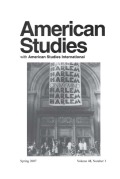Resumen
The Buffalo Skyway, a mile long and 110 feet high, opened in 1955 in an atmosphere of triumph and celebration, city planners certain that the enormous structure would invigorate the area's economy by eliminating troublesome rail and automobile bottlenecks between the city's downtown core and lakeshore plants and factories to the southwest. Today, the bridge is the whipping boy for politicians and regionalists, who view the structure as a concrete dinosaur, astride waterfront land that might otherwise be productively developed, ala Baltimore. This essay examines the cultural forces that produced the Skyway and many similar structures of the era. It contextualizes Buffalo's high-level bridge not just as an instrument of efficiency and commercial renewal, but as an icon of size and power, speed and mobility, movement and flight--a piece of 'structural art' in the mode of biomorphic, vital forms modernism, built and egineered for those who loved to drive, in the golden age of the American automobile.All items © Mid-America American Studies Association
Authors: If you prefer to remove your text(s) from this database please contact the editor.

